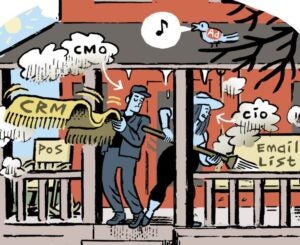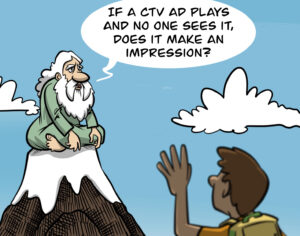 Twitter has a DM for brands: We care about DR.
Twitter has a DM for brands: We care about DR.
“We highly prize the ability to drive ROI,” said Richard Alfonsi, Twitter’s VP of global online sales.
So do most of Twitter’s competitors, with Pinterest, Instagram, Google and Facebook all at various stages of buy button rollout. It makes sense. Social platforms are starting to come to grips with the fact that branding is hard to measure. Performance is where the digital ad dollars are.
But you’ve got to spend money to make money. In 2013, Twitter bought mobile ad exchange MoPub, followed less than a year later by its acquisition of mobile retargeting company TapCommerce. In April, Twitter shelled out $532.6 million in stock to acquire digital commerce tech company TellApart.
As Twitter’s VP of product Kevin Weil noted in a blog post at the time of the TellApart purchase, “We’re making strong investments in our direct-response capabilities in order to enable advertisers to target the right users, drive action with creative ad units and simplify the measurement of conversion performance across devices.”
Of course, it’s not as simple as all that. Although Twitter’s monthly actives hit 302 million in Q1 2015, not all advertisers are wholly convinced of the platform’s DR street cred, including apparel retailer Bonobos, which has cut back on its Twitter ad spend, according to a recent report in The Wall Street Journal.
But for every Bonobos, there’s an eBay, which used Twitter’s website card product to drive a 59% quarter-over-quarter decrease in its average cost per click. Twitter has also worked on direct-response campaigns with Machine Zone, King.com, Draft King, Jackthreads, Paramount Pictures, Virgin America, Lyft and Jaguar Land Rover, the last of which uses Twitter’s “objective-based pricing” to only pay for engagements around specific KPIs, including lead generation.
“We’re only charging for the specific engagement types a brand wants, even if that means a short-term revenue hit to Twitter,” said Alfonsi, a self-described “bearer of the direct-response torch,” which he also carried over roughly five years in exec sales roles at Google.
Responsible for Twitter’s global online sales organization, including its global SMB and mid-market sales team, Alfonsi reports directly to Adam Bain, president of global revenue and partnerships.
AdExchanger caught up with Alfonsi, who recently hit his three-year Twitter anniversary.
AdExchanger: How does Twitter approach direct-response?
RICHARD ALFONSI: Creating value for advertisers is at the top of our priority list and it’s what we think about whenever we make choices on the product side.
Every direct-response campaign at Twitter includes three dimensions – targeting, creative and measurement – each of which is complementary one to the other.
What are Twitter’s plans in light of the TellApart acquisition?
TellApart has great direct-response DNA and they’ve established deep relationships over the years, especially with US-based retail businesses. They look at direct-response from a cross-device perspective and that fits in very nicely with our own viewpoint. Eighty-percent of Twitter usage happens on a mobile device. More and more often users are interacting with an ad on one device and converting on another.
TellApart has been focused solely on the US market, while Twitter has a global footprint. It’s a little early to say much about the road map, but I can say that you’re going to start to see my sales team take the TellApart solution globally. We’ll also be able to help them expand their footprint beyond the retail vertical.
Twitter is known for awareness building and branding more so that DR. How are you going to change that?
We’re working on building mindshare with marketers. It’s true that when Twitter started its ads business about four years ago, our strength was in upper-funnel awareness-type goals. You could even say that’s a core part of our DNA. But over the last year in particular, we’ve earned the right to play in the mid and lower funnel.
Measurement is especially important to us in terms of cross-device. The majority of ecommerce conversions still happen on a desktop, but there’s an increasing amount of engagement happening on mobile. It’s our job to educate advertisers to think about conversion attribution. People often revert to the click because it’s easy, but it’s becoming less and less relevant.
There’s been a lot of talk about buy buttons – Pinterest, Instagram, Facebook, Google. What’s the status of Twitter’s buy button?
The buy button is still on the experimental side. We’re testing it. But I can say that a buy button is the logical extension of our DR products in terms of closing the loop.
What DR ad products are you focusing on now?
We think of cards as our primary palette to deliver ad units natively in Twitter timelines.
Mobile app cards, for example, allow advertisers to drive app installs and take people directly to the App Store of Google Play, or they can help with re-engagement if a user already has an app on their phone.
The website card is meant to drive traffic from Twitter timelines to an advertiser’s site using a visual format and a clear call to action. And then there are the lead-gen cards which are designed to capture email addresses with one click on Twitter.
In terms of measurement, Twitter has moved away from timeline views toward cost per action. What was the motivation from a DR perspective?
We want to focus on the metrics advertisers care about, and direct response advertisers care about things like app installs, cost per install, conversions and cost per conversion. Our ad system is auction-based. People bid on certain types of engagements, but they only pay if the engagement happens, for example if there’s an app install or a click or an actual video view.
We also have a tag system that allows advertisers to track conversions so they can understand cross-device performance and attribution.
What do you want analysts and investors to know about Twitter that they don’t seem to know?
That these direct-response solutions work. Of course they don’t work for everybody and obviously we don’t have every detail worked out yet, but we’re making progress and we’re gaining traction as we iterate.
We’ve made some major investments and some big acquisitions. We bought TapCommerce, we bought TellApart, we partnered with Google – and all of that that makes it clear that direct-response has been a primary focus for us and will continue to be one.













